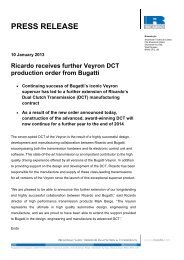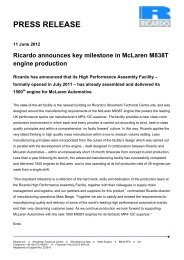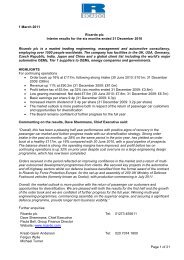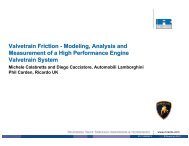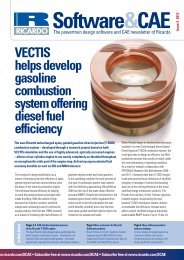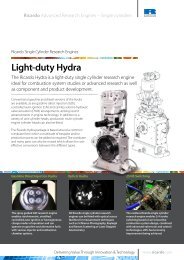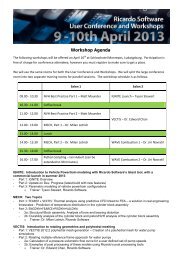Coupled Wave-Vectis Simulation of a Restricted Engine - Ricardo
Coupled Wave-Vectis Simulation of a Restricted Engine - Ricardo
Coupled Wave-Vectis Simulation of a Restricted Engine - Ricardo
Create successful ePaper yourself
Turn your PDF publications into a flip-book with our unique Google optimized e-Paper software.
Conclusions<br />
• WAVE is a very good tool by itself.<br />
– Good prediction <strong>of</strong> individual cylinder volumetric efficiency rankings<br />
even with one dimensional assumptions.<br />
– Still need WAVE to understand full rpm range intake wave dynamics<br />
and tuning effects. Quick solution times.<br />
• WAVE-VECTIS is excellent for getting a good understanding <strong>of</strong> actual<br />
pressure losses and their sources. Skin friction, turbulence generation,<br />
and separation losses can be analyzed.<br />
• Differences in intake manifold geometry had little impact on diffuser<br />
performance.<br />
• Small differences in total pressures losses did not immediately correlate<br />
to differences in engine volumetric efficiency.<br />
• Flow through restrictor is not completely choked even at 90% <strong>of</strong> engine<br />
redline.<br />
• Very small variations in engine performance for different placements <strong>of</strong><br />
flow bend to meet packaging requirements, from a flow loss standpoint.<br />
• Placement <strong>of</strong> bends can still have a large impact on intake tuning.<br />
University <strong>of</strong> Minnesota Formula SAE 20





